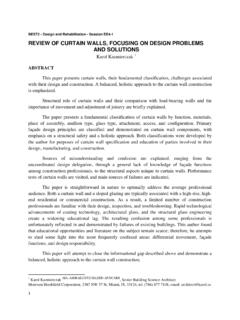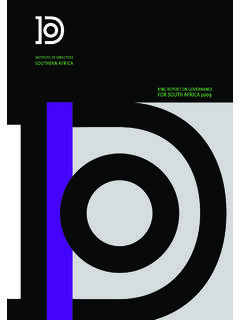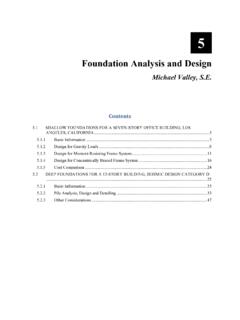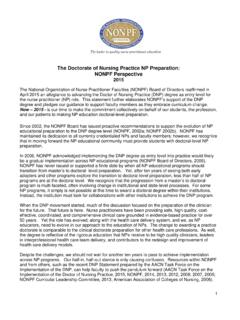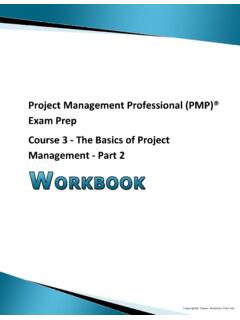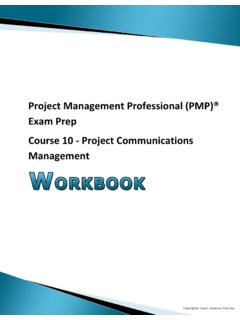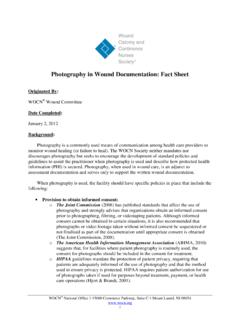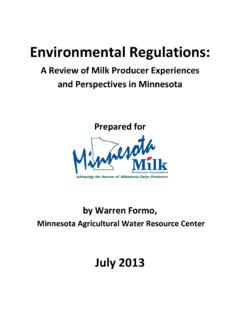Transcription of PVDF Architectural Coatings - cdn.ymaws.com
1 PVDF Architectural CoatingsTechnical PaperPVDF resin-based Architectural Coatings provide high- performance durability for metal building products. These resin systems are available for both liquid and powder Coatings . PVDF resin-based Coatings are combined with the hardness of acrylic to deliver durable, superior- performance coating systems that withstand the test of weather and under extreme conditions, these Coatings are proven to resist humidity, fading, chalking, abrasions and most chemicals, while retaining the intended color, gloss and appearance. Across North America, building owners, architects, contractors, product manufacturers and finishers have relied on PVDF Coatings for 50 NamesPVDF is the abbreviation for polyvinylidene difluoride.
2 PVDF is a fluoropolymer resin. Coatings containing fluoropolymer resins are produced by many manufacturers and branded with a variety of trademarked names. Unfortunately, it can be confusing for those outside of the Coatings industry to differentiate between the resin manufacturers and the coating Architectural Coatings from different coating manufacturers contain similar PVDF resins, the performance of the coating systems can vary widely. This is due to the proprietary formulations of each coating manufacturer. Hylar by Solvay Solexis and Kynar by Arkema Inc. are the two brands of PVDF resins most widely recognized in the They offer equivalent performance per industry standards for weathering. Every coating manufacturer s unique coating formulation includes resins, pigments, solvents and additives.
3 These are detailed in a separate section later in this 50 years, The Valspar Corporation has manufactured Fluropon brand 70% PVDF Architectural coating systems. Continuous improvements at Valspar have contributed to Fluropon s longevity, as well as resulted in additional branded PVDF Coatings . Valspar s PVDF Coatings are recognized for their enhanced application properties, dependable color consistency, and special formulations such as energy-efficient solar-reflective Coatings and color-changing ExpectationsFrom the roof to front door, PVDF resin-based Coatings protect and enhance numerous Architectural metal products. End-uses include: Metal roofing and wall panel systemsFraming for curtainwall, windows, skylights and entrance systems Louvers and grills, soffits, fascia, mullions, column covers and more These exterior metal products are manufactured from steel and aluminum coils, or from aluminum extrusions.
4 Coil and extrusion product guide specifications for shop-applied, exterior coating systems are available from PVDF coating manufacturers. These specifications should follow the Construction Specifications Institute (CSI) 3-Part Format and reference standards. Applicator and end-user expectations are influenced further by PVDF resin manufacturers that have earned a reputation for resin systems with weathering performance perceived as superior to all ensure PVDF Coatings perform and appear as intended and expected, regardless of the manufacturer, Architectural metal products typically are specified with reference to the project requirements and voluntary industry Resort & Casino, Las Vegas, NVValspar s 3-Part specification Guide 05 05 13 Shop-Applied Coatings for Metal provides in-depth specification information for architects.
5 American Architectural Manufacturers Association (AAMA) standards are considered the most stringent for Coatings applied to aluminum extrusions, panels and substrates. The AAMA also publishes standards for hot-dip galvanized and zinc-aluminum coated steel substrates. Additional guidance is provided through test procedures of ASTM International, formerly known as the American Society for Testing and Materials (ASTM). More information on these standards and test procedures is included later in this and Extrusion CoatingsPVDF resin-based Coatings are available for both coil and extrusion applications. Coil Coatings Coil-coated, or pre-painted, Architectural building products start out as flat sheets and are formed into shapes such as roof panels, wall panels, gutters and pre-manufactured metal buildings.
6 Substrates may include pre-treated hot-dip galvanized steel (HDG), (Galvalume ) and pre-treated aluminum. The National Coil coating Association s website explains: Coil coating is a continuous, automated process for coating metal before fabrication into end products. The metal coil is positioned at the beginning of the coating line, and in one continuous process, the coil is unwound, pre-cleaned, pre-treated, pre-primed and pre-painted before being recoiled on the other end and packaged for shipment. Extrusion Coatings While coil coating is applied to the metal prior to it being shaped into Architectural building products, the aluminum extrusion process creates the metal products first before a finish is applied.
7 The shape of the die determines the shape of the extrusion. Using aluminum billet and a powerful hydraulic press, extruders can produce almost any shape imaginable. Fenestration products are among the most common examples of extruded aluminum, such as framing for windows, curtainwall, storefront and entrance systems. 2 PVDF coating CompositionTo meet the industry s highest performance standards for Architectural metal products, 70% PVDF resin-based Coatings are recommended. The remaining 30% of the binder is composed of acrylic. Pigments, solvents and additives are also included in the formulated liquid product. For PVDF powder Coatings , the solvent is raw materials of these Coatings are: Resins (Binder) Coatings are often named for their resin type or blend, such as 70% PVDF and 30% acrylic blend.
8 For Coatings other than PVDF, common resin names are epoxy, polyester and urethane. Resins bind the coating to the substrate. They determine many coating properties, including weather resistance, physical properties, chemical resistance, color fade, chalk, and gloss retention. With 70% PVDF Coatings , the resin typically results in a medium- to low- gloss finish. Degradation of the resin system by ultraviolet (UV) exposure or hydrolysis results in chalking a visible whitish, powdery substance. As the resin system degrades, the coating surface gets rougher as pigment particles in the film become exposed. Combining the PVDF resin system with acrylic provides an added hardness and adhesive quality to the overall coating system. The acrylic must be selected carefully for compatibility with the PVDF and for premium UV resistance.
9 Pigments Pigments provide the coating with color, while hiding the primer and substrate. Depending on their chemistry, pigments impart color to PVDF Coatings by absorbing and reflecting visible light. The majority of the time, color is the most important design element to an Architectural coating . Not only does pigment color give a design beautiful aesthetic properties, but it also influences the coating s durability and can enhance its mechanical enhanced performance considerations, specialty pigments can impart additional solar-reflective, energy-saving properties for PVDF Coatings . For both aesthetic and performance criteria, it is essential to choose the right pigments. An important basis for the selection is an effective outdoor exposure as the binder that forms the paint film and are the principal components that determine the durability of the coating , its appearance and its performance .
10 Provide the color and influence the coating s durability. Maintain the liquid state and influence the ease of application, but are not used in powder the flow, cure rate and surface appearance, and also influence the liquidity and *ADDITIVES*Are not used in powder three types of pigments used in Architectural Coatings are: Inorganic, which generally are ceramic or mixed-metal oxide pigments Inorganic pigments are sourced from minerals that either have been mined and refined, such as red oxide, or have been synthesized at high temperatures, similar to firing ceramics. The coloration imparted by these pigments tends toward the earth tones of gray, brown, and muted reds and yellows. With few exceptions, inorganic pigments maintain their color for many years and even decades.
